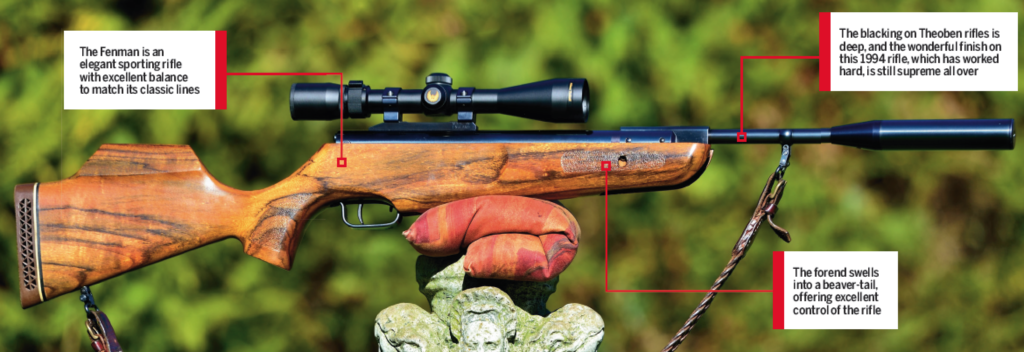Theoben Fenman: it looks good and shoots well too
Simon Everett praises the Theoben Fenman for its deep blacking and beautiful African hardwood stock – and the fact that it shoots well too.


Background to the Theoban Fenman
The Theoben Fenman was a diversion from the norm when it hit the headlines in August 1993. Theoben had officially been making gas-ram-powered air rifles since 1980 when they were granted the patent for the system, but Ben Taylor had the idea back in 1978 when he was working on a Suzuki GS1000 motorbike which had air-assisted forks.
The Fenman was an ultra carbine with an 8” barrel, when other carbines were twice the length or more – yet it was consistent, accurate and very well balanced. The gas-ram had a short lock time, but gained a reputation for harsh recoil. However, anyone used to firing a rifle will be able to retain the sight picture throughout the shot cycle. (Read our list of the best air rifle pellets.)
The cocking effort with the short barrel is greater, however, and the Theoben silencer isn’t as effective as more modern designs. (Read more on sound moderators for air rifles.)

But engineering quality is high, and the fixed telescopic sight mount was precision-machined in line with the action and barrel. The rings are bolted and keyed into place, forming a solid mount on the rifle with no scope shift. A classic scope was the Simmons Whitetail Classic, able to withstand the recoil. (Read scopes for air rifles.)
The High Efficiency gas-ram system, employed in the Theoben Fenman and later rifles, had a different piston seal material with a shaped crown. An inertia weight follows the piston forward and virtually eliminates piston bounce, improving the shot cycle and producing a shot-to-shot consistency in the order of five or six feet per second.

For fine-tuning the gas-ram, there is a Schrader valve that can be pumped just like a tyre, using the proprietary Theoben pump or a mountain bike pump.
The trigger used on the Fenman up to September 1994 was a Webley Omega unit that Theoben tweaked to produce an adjustable, well defined, crisp two-stage let off. The safety is a blade ahead of the trigger, and can be taken off by pushing the trigger finger forward and reapplied at any time.

Another feature of the Fenman was the use of an African hardwood called Hyedua (pronounced ‘shedua’) for the stocks. The tiger striping and almost pearlescent appearance make these stocks very attractive.
The wood is tough and difficult to machine, and became very hard to source due to forest protection. Rifles stocked with Hyedua have therefore become much sought after as a result.
This review was originally published in 2019 and has been updated.








